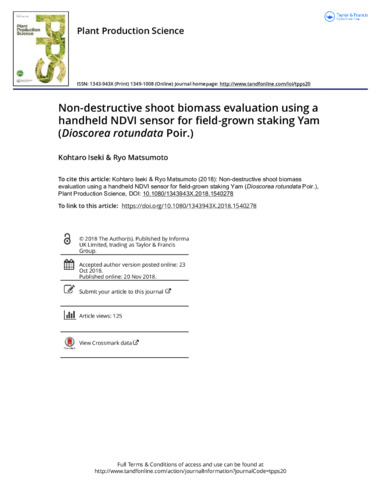Non-destructive shoot biomass evaluation using a handheld NDVI sensor for field-grown staking Yam (Dioscorea rotundata Poir.)
Abstract
Crop phenotyping is a key process used to accelerate breeding programs in the era of high-throughput genotyping. However, most rapid phenotyping methods developed to date have focused on major cereals or legumes, and their application to minor crops has been delayed. In this study, we developed a non-destructive method to predict shoot biomass by measuring spectral reflectance in staking yam (Dioscorea rotundata). The normalized difference vegetation index (NDVI) was evaluated using a handheld sensor that was vertically scanned from the top to the bottom of a plant alongside the stake. A linear regression model was constructed to predict shoot biomass through Bayesian analysis using NDVI as a parameter. The model well predicted the observed values of shoot biomass, irrespective of the growth stage and genotypes. Conversely, the model tended to underestimate the shoot biomass when the actual shoot biomass exceeded 150 g plant−1; this was compensated for when the parameter green area, calculated from plant image, was included in the model. This method reduced the time, cost, effort, and field space needed for shoot biomass evaluation compared with that needed for the sampling method, enabling shoot biomass phenotyping for a large population of plants. A total of 210 cross-populated plants were evaluated, and a correlation analysis was performed between the predicted shoot biomass and tuber yield. In addition to the prediction of tuber yield, this method could also be applied for the evaluation of crop models and stress tolerance, as well as for genetic analyses.

